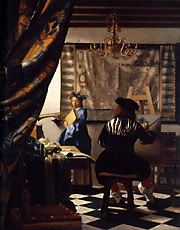

Sturdier easels typically involve a blocky and heavy structure, while portable easels are light-weight and three-legged. Most contemporary easels can be folded for storage.
An easel painting is one that is small enough to fit on an easel, and one with a support that permits it to be painted on one (unlike murals for instance).
(pr. ee'zl)
Easels depicted within paintings:

Bosporan Kingdom (on the Black Sea Coast),
Portrait Artist's Workshop Painted Sarcophagus
(detail), 1st century CE,
limestone, entire sarcophagus 81
x 215 x l 57 cm, State Hermitage Museum, St. Petersburg, Russia.
See studio.

Diego
Velázquez (Diego Rodríguez de Silva y Velázquez)
(Spanish, 1599-1660), The
Family of Philip IV, or "The Maids of Honor (Las Meninas)", c. 1656, oil
on canvas, (318 x 276 cm),
Prado Museum, Madrid.
 This
is a group portrait
of an exceptional sort:
This
is a group portrait
of an exceptional sort:
In the center-foreground
is the infanta (princess) attended by her meninas (maids of honor)
— companions
 including
two young ladies, a dwarf, a child, a dog, a nun, and a tutor.
including
two young ladies, a dwarf, a child, a dog, a nun, and a tutor.
This little party is visiting the studio
where Velázquez stands before his canvas. We see the back of it, perched upon
an easel. The painter and most of the others look toward the
king and queen
 as
they pose for the painting in progress.
as
they pose for the painting in progress.
The king and queen would not actually be
visible in this picture if their reflected
image could not be seen in a mirror
placed on the opposite wall. Altogether this is a view, which
could only be seen by the king and queen themselves, as
 they pose for their
portrait. The point of view
of every person who gazes
upon this painting is that of the king and queen of Spain. A
very privileged vantage indeed!
they pose for their
portrait. The point of view
of every person who gazes
upon this painting is that of the king and queen of Spain. A
very privileged vantage indeed!
Further
increasing the sense that we are present at a specific moment
is our glimpse of a man in the distant doorway, pausing as he
descends or ascends — either entering or exiting the chamber.
See Baroque,
genre, self-portrait,
and Spanish art.

Adriaen van Ostade (Dutch, 1610-1685), detail
of The Artist's Workshop, oil
on canvas. See mahlstick
and studio.

Johannes Vermeer (Dutch, 1632-1675), Allegory
of Painting (The Painter in His Studio), c. 1666, oil on canvas,
130 x 110 cm, Kunsthistorisches Museum, Vienna. The model personifies
Clio, Muse of History,
holding the trumpet of fame in her right hand and the chronicle
of world events in her left. Attributes
of other muses, including a mask,
lie on the table. These make the painter a narrator of stories.
See paint-by-number.
Pierre-Auguste Renoir (French, 1841-1919), Monet Painting in His Garden at Argenteuil, 1873, oil on canvas, 18 x 23 1/2 inches, Wadsworth Atheneum, CT. See en plein air and Impressionism.
Also see beret, brush, palette, and smock.
https://inform.quest/_art
Copyright © 1996-![]()